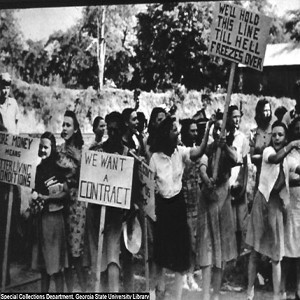
On this day in labor history, the year was 1934.
That was the day nearly half a million textile workers, from Maine to Alabama, walked off the job in a general strike.
The United Textile Workers had launched an organizing campaign the year before.
Within months their membership had grown from 15,000 to well over 250,000.
Working conditions and pay were abysmal.
The normal workweek averaged 55 hours.
Child labor was widespread and workers were always in fear of mill closings, pay cuts and firings for suspected union activity.
In the South, the industry had essentially been in a depression since the early 20s.
The key issue was the ‘stretch-out”.
Workers were routinely expected to complete an increasing amount of work at the same rate and wage.
For a brief moment, workers hoped their conditions would change when President Roosevelt signed the Code of Fair Competition the previous summer.
It raised wages, limited hours, and prohibited child labor.
It also allowed for union organizing.
But the mill owners maneuvered around the code effectively and the Textile Relations Board refused most workers complaints.
Fed up, workers walked out of the mills by the hundreds of thousands.
They used the flying squadron tactic employed by Minneapolis Teamsters earlier that year, traveling from town to town, from mill to mill, calling workers out on strike.
Mill owners were shocked.
Within days, strikers confronted thousands of police and scabs.
More than 40,000 National Guardsmen were called out in 16 states.
Over the course of the strike, sixteen were killed and hundreds injured.
After 22 days, union leaders called off the strike when President Roosevelt promised a government survey of industry conditions.
It was an outrage, a betrayal and a defeat felt for decades.
More Episodes
 2024-03-01
2024-03-01
 2024-02-29
2024-02-29
 2024-02-27
2024-02-27
 2024-02-26
2024-02-26
 2024-02-24
2024-02-24
 2024-02-20
2024-02-20
 2024-02-18
2024-02-18
 2024-02-17
2024-02-17
 2024-02-17
2024-02-17
 2024-02-13
2024-02-13
Create your
podcast in
minutes
- Full-featured podcast site
- Unlimited storage and bandwidth
- Comprehensive podcast stats
- Distribute to Apple Podcasts, Spotify, and more
- Make money with your podcast
It is Free
- Privacy Policy
- Cookie Policy
- Terms of Use
- Consent Preferences
- Copyright © 2015-2024 Podbean.com




